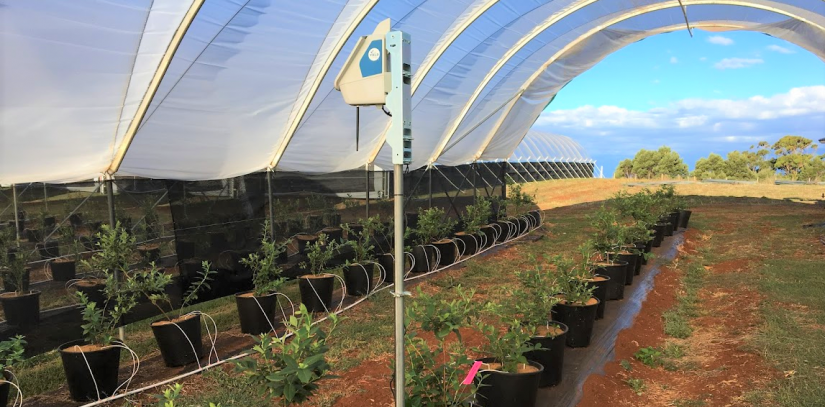At the start of 2020 one of Australia’s leading fresh food growers, the Costa Group, started rolling out a technology innovation: an in-crop sensor and data analytics system called Sensing+ and Sensing+ Enterprise Analytics, a new yield prediction module.
Sensing+, developed by agriculture technology startup The Yield Technology Solutions, combines sensors and analytics to produce information that helps large commercial growers of irrigated perennials make important on-farm decisions such as when to plant, feed, irrigate, protect and harvest.
The Yield Prediction module – the result of a collaboration involving The Yield, Costa Group, the Food Agility Cooperative Research Centre and the University Technology Sydney (UTS) – then helps growers more accurately predict how much crop they’ll be able to send to buyers like the major supermarket chains
“We want to better understand and manage the specific growing conditions that improve the quantity and quality of our yields,” says Costa Group CEO Harry Debney.
Costa’s berries are grown in protective tunnel structures. The Sensing+ system measures the growing conditions inside those microclimates, using AI to provide in-tunnel weather predictions.
We’ve been impressed with the accuracy achieved to date compared with our manual approach.
— Harry Debney, CEO, Costa Group
“We’re also rolling out the Sensing+ Yield Prediction module, which predicts our berry yields using AI and data from both our harvest management systems and the microclimate weather,” Debney says. “We’ve been impressed with the accuracy achieved to date compared with our manual approach.”
Costa is rolling out Sensing+ and the new yield prediction module at eight berry farms in NSW, Queensland and Tasmania.
Sensing+ measures microclimate at the farm, block, row and even what’s known as the ‘hot spot’ level every 15 minutes, the founder and Managing Director of The Yield, Ros Harvey, explains. AI and machine intelligence then predict growing conditions at the points that have been measured.
This is more precise than information based on averages available via traditional weather services and a digital leap forward from traditional hands-on observations conducted periodically in the field.
The yield prediction module then combines the microclimate data with the grower’s historical and current crop data to forecast output.
“That helps the grower to better plan their labour, equipment and logistics to maximise efficiency and control costs,” says Associate Professor Daniel Ramp, who leads a team of researchers embedded in the Sydney office of The Yield for this project.
In turn, this means growers have more certainty and can negotiate better prices with big buyers. Even a small improvement in the accuracy of yield forecasts can mean significant financial benefits to a large producer, he says.
AI will one day be absolutely standard in the agricultural industry.
— Ros Harvey, Managing Director, The Yield
Harvey says AI will one day be ‘absolutely standard’ in the agricultural industry. “Probably the biggest change this industry will have to make is that we’ll go from biophysically modelling the world to using AI to model the world,” she says. “If you look at the Yield Prediction project, it’s precisely that leap that has happened.”
Previously, people believed it was impossible to predict yield on berries because every single growth stage was on the plant at the same time, she says. “Can you can imagine trying to create a biophysical model simulating that? It was impossible. But you can do it using AI.”
Harvey says optimising production is important amid predictions that the world will need 60 per cent more food by 2050. “If that’s the case, how are we going to feed the world without wrecking the planet? The answer is that by using AI we can reduce waste and produce more food.”
Associate Professor Ramp also sees wide and long-term impacts of the work. “Growers are getting a much better understanding of how weather patterns and longer-term climate trends are influencing their operations,” he says. “That not only helps their forward planning, it could also help the banking sector direct finance on those farms that are able to show sustainability and resilience to climate change.”
A team of three from UTS – experts in data analytics and AI – continue to work with The Yield to further develop the models for the yield prediction module, which has been commercialised just six months into a two-year research program.
“This is a great example of how, using data and agile research methods, we can get research results out of the lab and into the field faster,” Food Agility’s Chief Scientist, Professor David Lamb, says.
“The incorporation of the research team with an industry partner, the co-design of the fundamental questions, and the agile approach to project delivery ensured a direct pathway to impact,” he says. “It’s a great example of true collaboration – with our industry partners learning from our researchers, and our researchers learning from our industry partners.”
Research team
-
Associate Professor, School of Life Sciences
-
Marine DesprezResearch Fellow, School of Life Sciences
-
Boyu JiResearch Fellow, School of Life Sciences
-
Kyle ZawadaResearch Assistant, School of Life Sciences
Faculty and research centre
- Food Agility CRC, Faculty of Science
- School of Life Sciences
Funded by
- The Yield Technology Solutions
- University of Technology Sydney




